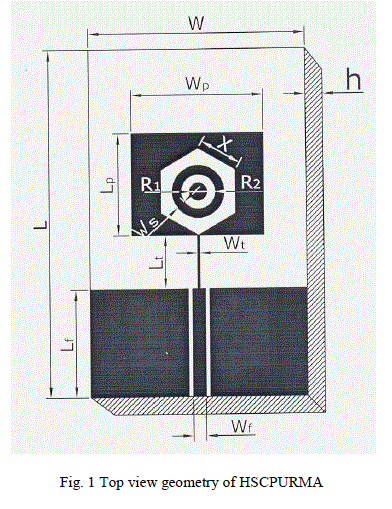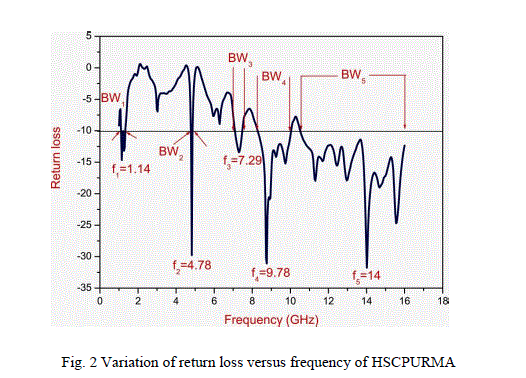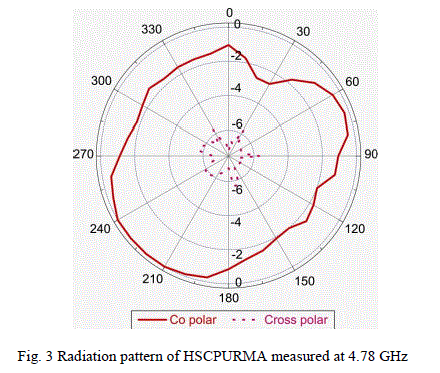ISSN ONLINE(2278-8875) PRINT (2320-3765)
ISSN ONLINE(2278-8875) PRINT (2320-3765)
M. Veereshappa1 and Dr. S.N Mulgi2
|
| Related article at Pubmed, Scholar Google |
Visit for more related articles at International Journal of Advanced Research in Electrical, Electronics and Instrumentation Engineering
A novel design and development of unipolar rectangular microstrip antenna is proposed for virtual size reduction and penta-band operation. The antenna structure consisting of pentagon shaped slot with dual circular parasitic strip etched on the centre axis of the radiating patch. The antenna gives a maximum virtual size reduction of 62 % and penta it operates in the frequency range of 1 to 16 GHz. The proposed antenna is simple in its structure and use low cost substrate material. The antenna gives ominidirectional radiation characteristics with peak gain of 11.71 dB. The proposed antenna may find application in microwave communication systems
Keywords |
| Microstrip Antenna, Unipolar, Slot, Ominidirectional, Parasitic Strip. |
INTRODUCTION |
| Microstrip slot antennas are useful in a broad range of application due to their low profile, low cost, light weight, planar configuration and easy fabrication. The microstrip antenna is the better choice for these requirements. There is a great need to design compact slot antennas for mobile communication systems. There are several techniques which are used to reduce the virtual size of the antennas. These techniques including use of different shaped slots, truncation, parasitic strip etc. Number of investigations have been reported in the literature to achieve virtual size reduction up to about 22 % by embedding cross slots on radiating patch [3], truncated corners shows 19 % virtual size reduction [4], double C-slot microstip antenna to have a gain of 6.46 dBi and virtual size reduction of 37 % [5], slotted rectangular microstip antenna to achieve maximum virtual size reduction around 50 % [6], multi-feed and multi-band operation [7], simple monopole antenna for UWB operation [8] etc. Most of the antennas presented in the literature are efficient to show maximum virtual size reduction up to 50 % with complex structure or bigger in size. In this paper a simple technique has been demonstrated to construct the unipolar microstrip antenna for virtual size reduction and penta-band operation. The antenna gives highest virtual size reduction and high gain by loading hexagon slot and two circular parasitic strips etched along the centre axis on the radiating patch. The proposed antenna gives ominidirectional radiation characteristics. The obtained results are quite good compared to the literature values. |
DESIGN OF ANTENNA GEOMETRY |
| The art work of the proposed antenna is sketched by using computer software Auto-CAD to achieve better accuracy and is fabricated on low cost FR4-epoxy substrate material of thickness of h = 0.16 cm and permittivity εr = 4.4. |
| Figure 1 shows the top view geometry of low profile hexagon shaped slot loaded and circular parasitic strips unipolar rectangular microstrip antenna (HSCPURMA). In Fig.1 the area of the substrate is L ïÃâô W cm. On the top surface of the substrate a ground plane of height which is equal to the length of microstripline feed Lf is used on either sides of the microstripline with a gap of 0.1 cm. On the bottom of the substrate a continuous ground copper layer of height Lf is used below the microstripline. The HSCPURMA is designed for 3 GHz of frequency using the equations available for the design of conventional rectangular microstrip antenna in the literature [2]. The length and width of the rectangular patch are Lp and Wp respectively. The feed arrangement consists of quarter wave transformer of length Lt and width Wt which is connected as a matching network between the patch and the microstripline feed of length Lf and width Wf. A semi miniature-A (SMA) connector is used at the tip of the microstripline feed for feeding the microwave power. In Fig.1 a hexagon slot is loaded at the centre axis of the radiating patch and two circular parasitic strips is etched on the radiating patch. The vertices of hexagon slot, the inner, outer radius, and width of parasitic strips is X, R1, R2 and Ws respectively. The design parameters of the proposed antenna is given in Table 1 |
 |
 |
EXPERIMENTAL RESULTS AND DISSCUSION |
| The antenna bandwidth over return loss less than -10 dB is tested experimentally on Vector Network Analyzer (Rohde & Schwarz, Germany make ZVK model 1127.8651). The variation of return loss verses frequency of HSCPUMA is as shown in Fig. 2. From this graph the experimental bandwidth (BW) is calculated by using the equation, |
 (1) (1) |
| were, f1 and f2 are the lower and upper cut of frequencies of the band respectively when its return loss reaches – 10 dB and fc is the centre frequency of the operating band. From this figure, it is found that, the antenna operates between 1 to 16 GHz and gives five resonant modes at f1 to f5, i.e. at 1.14, 4.82, 7.29, 9.78 and 14 GHz respectively. The magnitude of experimental -10 dB bandwidth measured for BW1 to BW5 by using the equation (1) is found to be 230 MHz (18.62 %), 100 MHz (2.08 %), 380 MHz (5.21 %), 1.77 GHz (19.37 %) and 5.49 GHz (41.41 %) respectively. The resonant mode at 1.14 GHz is due to the fundamental resonant frequency of the patch and others modes are due to the novel geometry of HSCPURMA. The multi mode response obtained is due to different surface currents on the patch. The fundamental resonating mode f1 is shifted from designed frequency 3 GHz to 1.14 GHz due to the coupling effect of microstripline feed and top ground plane of HSCPURMA which gives a virtual size reduction of 62 % when compared to the designed frequency of 3 GHz. The gain of the antenna measured by absolute gain method [8]. The peak gain of the antenna is found to be 11.71 dB in their operating bands. |
 |
| The co-polar and cross-polar radiation pattern of HSCPURMA is measured at 4.78 GHz and is as shown in Fig 3. The obtained pattern is ominidirectional in nature. |
 |
CONCLUSION |
| From the detailed experimental study, it is concluded that, the HSCPURMA with microstripline feed gives penta band operation and gives a highest virtual size reduction of 62 %. The proposed antenna is simple in its structure and use low cost substrate material FR4. The antenna operates between 1 to 16 GHz and gives ominidirectional radiation characteristics with peak gain of 11.71 dB. The proposed antenna may find application in microwave communication systems. |
ACKNOWLEDGEMENTS |
| The authors would like to thank Dept. of Sc. & Tech. (DST), Govt. of India. New Delhi, for sanctioning Vector Network Analyzer to this Department under FIST project. The authors also would like to thank the authorities of Aeronautical Development Establishment (ADE), DRDO Bangalore for providing their laboratory facility to make antenna measurements on Vector Network Analyzer. |
References |
|